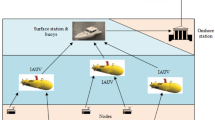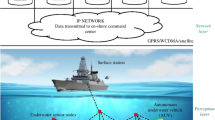Abstract
The use of underwater acoustic data has rapidly expanded with the application of multichannel, large-aperture underwater detection arrays. This study presents an underwater acoustic data compression method that is based on compressed sensing. Underwater acoustic signals are transformed into the sparse domain for data storage at a receiving terminal, and the improved orthogonal matching pursuit (IOMP) algorithm is used to reconstruct the original underwater acoustic signals at a data processing terminal. When an increase in sidelobe level occasionally causes a direction of arrival estimation error, the proposed compression method can achieve a 10 times stronger compression for narrowband signals and a 5 times stronger compression for wideband signals than the orthogonal matching pursuit (OMP) algorithm. The IOMP algorithm also reduces the computing time by about 20% more than the original OMP algorithm. The simulation and experimental results are discussed.
Similar content being viewed by others
References
SAYOOD K. Introduction to data compression [M]. United States: Newnes Press, 2006.
JAIN A K. A fast Karhunen-Loeve transform for a random processes [M]. Chicago: IEEE Computer Society, 1974, 24: 1023–1029.
TURCZA P, DUPLAGA M. Low-Power image compression for wireless capsule endoscopy [C]// IEEE International Workshop on Imaging Systems and Techniques-IST. Krakow, Poland, 2007: 1–4.
MO Y B, QIU Y B, LIU J Z, LING Y X. A data compression algorithm baseed on adaptive huffman code for wireless sensor networks [C]// Intelligent Computation Technology and Automation (ICICTA). 2011: 3–6.
SHEN Yan-chun, GUAN Yu-jun, WANG Fang, LUN Zhi-xin. The investigation of image compress coding based on wavelet transformation [C]// International Conference on Future Information Technology and Management Engineering. 2010: 324–326.
BERGER C R, ZHOU S L, PREISIG J C. Sparse channel estimation for multicarrier underwater acoustic communication: From subspace methods to compressed sensing [J]. IEEE Transactions on Signal Processing, 2010, 58(3): 1708–1721.
DONOHO D L. Compressed sensing [J]. IEEE Transactions on Information Theory, 2006, 52(4): 1289–1306.
TROPP J A, GILBERT A C. Signal recovery from random measurements via orthogonal matching pursuit [J]. IEEE Transactions on Information Theory, 2007, 53(12): 4655–4666.
BOASHASH B, O'SHEA P. A methodology for detection and classification of some underwater acoustic signals using timefrequency analysis techniques [J]. IEEE Transactions on Acoustics, Speech and Signal Processing, 1990, 38(11): 1829–1841.
CANDES E J, TAO T. Near-optimal signal recovery from random projections: universal encoding strategies [J]. IEEE Transactions on Information Theory, 2006, 52(12): 5406–5425.
DAVENPORT M A, WAKIN M B. Analysis of orthogonal matching pursuit using the restricted isometry property [J]. IEEE Transactions on Information Theory, 2010, 56(9): 4395–4401.
ZHANG Ge-sen, JIAO Shu-hong, XU Xiao-li, WANG Lan. Compressed sensing and reconstruction with bernoulli matrices [C]// IEEE International Conference on Information and Automation. 2010: 455–460. (in Chinese)
GAN Lu, LI Ke-zhi, LING Cong. Golay meets hadamard: Golaypaired hadamard matrices for fast compressed sensing [C]// IEEE Information Theory Workshop. 2012: 637–641.
TANG Gui-lin, QIU Yun-ming. Improved least square method apply in ship performance analysis [C]// International Conference on Advanced Computer Theory and Engineering (ICACTE). 2010: 594–596.
MARQUARDT D W. An algorithm for last-squares estimation of nonlinear parameters [J]. Journal of the Society for Industrial and Applied Mathematics, 1963, 11(2): 431–441.
LI Ling-zhi, ZOU Bei-ji, ZHU Cheng-zhang. Improved nonconvex optimization model for low-rank matrix recovery [J]. Journal of Central South University, 2015, 22(3): 984–991.
Author information
Authors and Affiliations
Corresponding author
Additional information
Foundation item: Project(11174235) supported by the National Natural Science Foundation of China; Project(3102014JC02010301) supported by the Fundamental Research Funds for the Central Universities, China
Rights and permissions
About this article
Cite this article
Guo, Xl., Yang, Kd., Shi, Y. et al. An underwater acoustic data compression method based on compressed sensing. J. Cent. South Univ. 23, 1981–1989 (2016). https://doi.org/10.1007/s11771-016-3255-1
Received:
Accepted:
Published:
Issue Date:
DOI: https://doi.org/10.1007/s11771-016-3255-1




